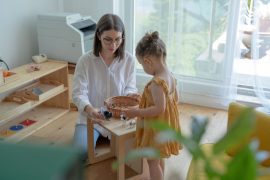By Miriam McCaleb
When we think about adults spending quality time with children, I wonder if it’s just me, or does your mind go straight to sentimental sorts of scenes: cosy board games by the fire, baby crawling through the daffodils of his first spring, perhaps a slow-motion shot of family laughing as child toddles through lapping waves.
If I were to ask you to imagine an adult spending quality time with a child, to consider a rich opportunity for relationship strengthening or visualise a learning interaction, I don’t reckon you’d visualise a nappy change. But perhaps we should. Perhaps the journey to self begins on the nappy change table.
If you’re reading this, you are probably fairly interested in child development and you will know how powerful early relationships are in impacting our social skills: our ability to read cues, to respond to and empathise with others, and that these abilities serve as powerful predictors of things like school success and later relationship health.
Those of us who are interested in brain science understand that repetition is one of the key principles for reinforcing learning and building brains. We know that infants and young toddlers are particularly malleable at a foundational level: their ‘habits of mind’ are being formed, they are waist-deep in the fundamentals of identity formation.
So while our memories might grasp onto “special occasion” moments as examples of quality time, our brains are actually built on the everyday minutiae, the day-in, day out activities so often disdained for being just routine.
Please join me in rethinking this idea, just for a moment. Consider that most children are reported to enjoy around 5000 nappy changes in their lifetime. These are interactions that are happening anyway – these are, if you choose to think of it like this, tasks that must be done.
A nappy change interaction can be swift and clinical, making maximum use of distraction as a tool for getting jobs done. The distraction might be that of the adult (cricking phone under neck or sending a text message) or it might be the child who is distracted, encouraged to lavish attention on something other than the adult.
Instead, imagine the way that nappy change routines can be an oasis of relational connection in a busy, busy world. They offer the chance for adult and child to share gaze and conversation, smiles and song.
Children who are consistently handled with kind hands and good humour are far more likely to radiate those gifts back to the world. Imagine how you might handle a nappy change routine differently if you weren’t consistently rushing to get it finished, but you were instead seeing it as an opportunity for unhurried, relational strengthening (with poo-be-gone benefits).
These daily acts of mothering/fathering/caregiving provide an inbuilt opportunity for children to experience intimacy – especially when their adults hold an intention to build and nurture the relationship, to attune to the needs of their children, as well as achieve the practical goal represented by the routine.
It is helpful to view all care routines in this way, to see that feeding a baby is an opportunity for shared intimacy, warmth and the beginnings of conversation – and to consider that nappy changes are an extension of the feeding and nurturing routine.
Babies aren’t necessarily aware of a separation: what happens at the top half of their personhood in comparison to what is happening in the bottom half, but they are certainly aware of how good it feels to be held gently, spoken to warmly, smiled at by a loving and familiar face. And we are aware of the power of the repetitious.
Remember, children don’t delineate their experiences into “educational and relationship enhancing opportunities” and “other” – the act of supporting a toddler into gumboots is just as full of rich learning as the splashing in puddles to follow.
Let’s pledge to say the word “routine” with reverence, and imagine that the very familiarity of the event creates a framework that allows us to pay even closer attention to the person we’re caring for.
Reprinted with permission from Brainwave Trust, www.brainwave.org.nz











